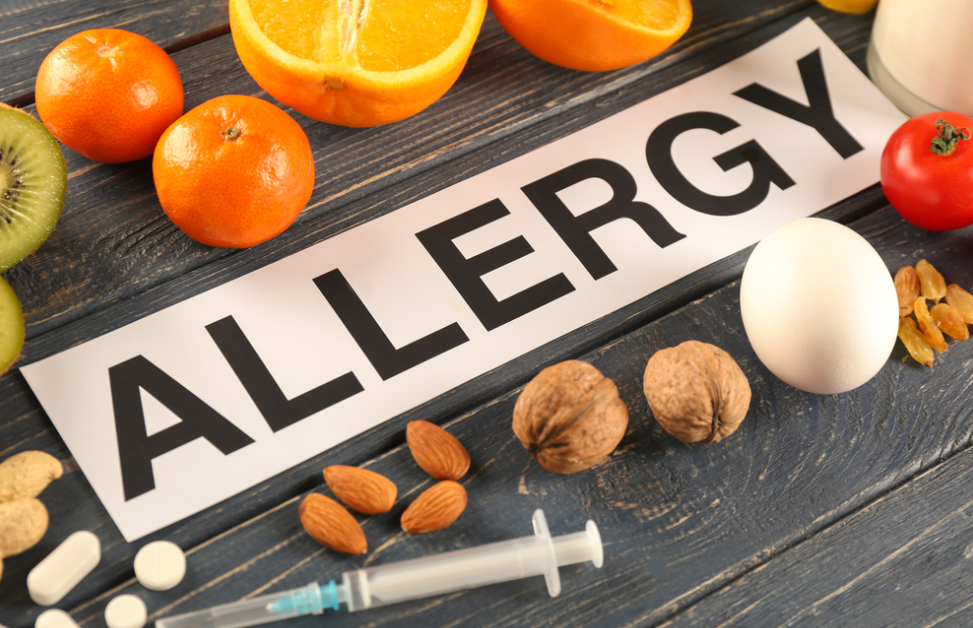An allergy is an intolerance of the immune system to specific substances. You’re allergic to these substances when your body reacts adversely to them, thereby producing excessive histamine, which triggers a cascade of allergic symptoms that can affect the respiratory system, gastrointestinal tract, skin or cardiovascular system. The most common allergies are listed below:
Milk Allergy
A Milk Allergy refers to the adverse reactions that involve one or more proteins of milk, whether belonging to the whey protein or casein group. A milk allergy is relatively common in children, affecting over 3% of infants, because cow’s milk is usually the first substance a baby encounters. However, this condition can develop into other allergic reactions from other protein sources when the baby grows into childhood and then adulthood.
Milk allergy symptoms can appear immediately after consumption or several hours (and even days) after the intake of cow’s milk. Among the children and adults who experience this condition, the most common symptoms include nausea, diarrhea, vomiting, abdominal cramps and other problems involving the skin, such as eczema or hives.
A Peanut Allergy
According to some recent statistical data, as many as 1.5 million Americans are reported to suffer from a peanut allergy. Even more frightening, the peanut allergy is also the main cause of anaphylaxis. 80 percent of the cases of this lethal allergic reaction are related to a peanut allergy.
The symptoms associated with a peanut allergy are similar to the symptoms experienced by other allergies. However, a peanut allergy is far more likely to result in anaphylaxis. This reaction is characterized by wheezing, diarrhea, nausea, vomiting and dizziness. Your pulse can be either very weak or very fast, and the situation will require immediate attention.
A Fish Allergy
A fish allergy is more likely to come on in adulthood. It can be triggered by salmon, cod, tuna, snapper, etc. It’s also fairly common that an allergic reaction to one fish may eventually spread to include a number of other types of fish.
At its mildest, you may experience some itching in the mouth or some mouth tingles after eating fish. At its worst, a fish allergy can result in anaphylactic shock. This reaction causes the swelling of tissues and can cause breathing, cardiac, and gastrointestinal difficulties
A Soy Allergy
Vegetarians and health enthusiasts have known for years that foods rich in soy protein offer a good alternative to meat, poultry, and other animal-based products. As consumers have pursued healthier lifestyles in recent years, consumption of soy foods has grown steadily, bolstered by scientific studies showing health benefits from these products.
Common symptoms of soy allergies include: eczema and acne-like rashes, nasal congestion, asthma, swelling, canker sores, fever blisters, hay fever, low blood pressure, itching, breathing problems, fatigue, vomiting, diarrhea and in some severe cases anaphylaxis.
A Wheat Allergy
Some food allergies are not allergies at all. In reality, they’re simply a food intolerance. This extends to wheat allergies as well. The truth is this: only a very small percentage of the population suffers from true wheat allergies. Many others, who believe they’re suffering from a wheat allergy, are simply experiencing an intolerance.
A true allergic reaction to wheat and wheat products comes on quite suddenly and can actually be life threatening. In fact, you may very well experience anaphylactic-type symptoms such as hives, swelling, difficulty breathing, coughing, and vomiting. A person experiencing an allergic response to wheat requires immediate medical attention or otherwise risks serious complications and possibly even death.
An Egg Allergy
An egg allergy is most commonly found in children below the age of five, and they are most likely to gradually grow out of it after the age of five. It’s the protein in the egg white that’s usually responsible for the allergic reaction, though in some cases the protein found in the yolk can be responsible.
Symptoms of an egg allergy reflect the symptoms of most food allergies and include skin rashes and eczema, hives, nausea, vomiting, diarrhea, difficulty breathing, coughing, sneezing, runny eyes and nose, and wheezing. A severe egg allergy can result in anaphylaxis, which closes the respiratory tract, causing the inability to breathe normally. This can be fatal in some cases and is especially dangerous in the case of infants.
A Tree Nut Allergy
Affecting millions of people worldwide, a tree nut allergy is often mistaken as a peanut allergy. However, while dried fruits cause a tree nut allergy, peanut allergies are caused by different kinds of legumes. The symptoms of these two conditions are alike, however. And it’s worth noting that a person allergic to one isn’t necessarily allergic to the other.
Allergies to tree nut products are usually more prevalent in children, but they may also occur with adults. Just as with other allergies, it’s treated by avoiding the foods that come from the source of the allergen – in this case, nut particles, oils and tree nuts. Tree nuts include all kinds of nuts that grow on trees, such as walnuts, pecan, pistachio, cashews, hazelnuts, filbert, hickory nuts, almonds, macadamia, beechnuts and chestnuts.
Common symptoms of this condition include skin reactions including eczema, rashes, itching, swelling, inflammation and hives. A tree nut allergy can also cause gastrointestinal symptoms, such as vomiting, stomach pains and diarrhea. Some severe cases experience nausea, rapid heartbeat and loss of breath.



